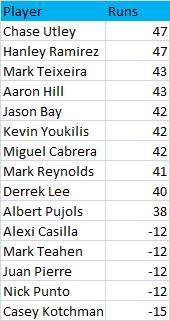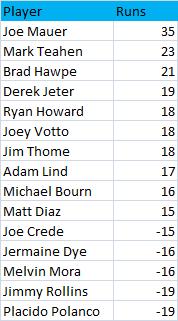
| Touching Bases | December 26, 2009 |
My first post on this site in February borrowed the main idea of Dave Studeman's batted ball reports, except instead of looking at the trajectory of batted balls, I grouped them by vector. A full season has passed, so who were the best pull hitters in baseball this year?
Value of Pulled Batted Balls

Chase Utley and Hanley Ramirez were both worth about 40-45 runs above average with the bat on the year. Utley got some value out of walking and taking his HBPs, but the bulk of their value at the plate came from them pulling balls. Reading John Walsh's piece in this year's Hardball Times Annual, I realized that Utley and Hanley weren't fully appreciated because their contributions outside the batter's box were equally valuable. Their baserunning, position, fielding value, and ability to stay on the field add another 40-45 runs to their value.
Albert Pujols and Kevin Youkilis returned from last year's top ten, while Dan Uggla, second last year, finishes one spot outside the top ten.
I think part of the reason that Youk and Jason Bay are listed is that they play get to take advantage of the Green Monster. I'm not trying to discredit them, since they're both excellent right-handed hitters, but I am trying to discredit Dustin Pedroia and Mike Lowell. Here is the average run value of pulled fly balls and line drives for Boston's four main RHBs since 2008.
| Player | Home | Away | Diff |
|---|---|---|---|
| Kevin Youkilis | 0.58 | 0.48 | 0.10 |
| Jason Bay | 0.52 | 0.43 | 0.09 |
| Mike Lowell | 0.47 | 0.26 | 0.21 |
| Dustin Pedroia | 0.40 | 0.22 | 0.18 |
Lowell pulls half his balls in play, too, so I doubt there's any park that he'd rather play in than Fenway. As for Pedroia, he has a career .332/.391/.505 line at home. On the road, he hits .283/.350/.406. He has never hit a 400-foot home run in his career according to Hit Tracker. I doubt anybody is more suited for his home park than Pedroia is for Fenway.
At the bottom of the list is Casey Kotchman, who I believe is the only first baseman to have totaled a negative value on pulled balls. Over a quarter of Kotchman’s balls in play were pulled groundballs, and he hit .073 on those. In 2008, a whopping third of his balls in play were pulled grounders, though he managed to hit .154 on them, so it's possible defenses have figured him out.
Value of Center Field Batted Balls

Both Phillies repeat on this leaderboard from last year, while O-Cab and Pedroia again prove their ineptitude at hitting the ball up the middle.
Ryan Howard focused his prodigious power to center this year. Previously, Howard hit the plurality of his home runs the opposite way three times in his career, and in 2007, he had pulled the highest share of his homers, but this year, he hit a remarkable 21 of his 45 homers to center. Mark Reynolds came closest to matching Howard with 17 home runs to center.
Value of Opposite Field Batted Balls

Joe Mauer’s 35-run total is absurd. He was worth 13 runs going the other way last year and his -10 runs on pulled balls actually was a league low. Now, he's cracked both the center field and opposite field top ten, and his futility pulling the ball was skimmed down to -5 runs. Mauer hit 34% of his balls to the opposite field, while the league average is 27%. His backup Mike Redmond hits the highest rate of balls the other way in the league.
Only Adrian Gonzalez hit more opposite-field homers than Joe Mauer this year. Adrian Gonzalez in Fenway Park would be scary. Derek Jeter, who’s always had opposite field power, hit the most home runs to right field batting right handed this year, possibly rejuvenated by the even shorter short porch at the New Yankee Stadium. In 2008, Jeter had better luck going the other way with his fly balls when he was on the road than he did when he was at home. That split did not continue in 2009. Jeter produced slightly better results on flies to right in the New Yankee Stadium than he did while playing on the road.
Jimmy Rollins' batted ball profile continues to perplex. He hit an anemic .200 on grounders this year, below his already mediocre .231 career average. Though speed is important for batters to reach base safely on grounders, spraying the ball to all fields might be even more weighty. Rollins hit only 7% of his groundballs the other way, which allows defenses to shift their fielders to one side of the field, and signifies that he's rolling over on the ball when he hits grounders. Placido Polanco, Jermaine Dye, and Joe Crede all hit over a third of their flies to the opposite field, but under 5% of those balls fall for hits.
A spreadsheet containing the full results can be found here. Batted ball location data via MLBAM. The field was partitioned equally into thirds to classify right/center/left.
Comments
Jeremy, this is excellent work. You're going to put me out of business!
Seriously, as the Casey Kotchman example shows, I assume that a key driver for some of these variances is the ground ball rate for each vector?
Posted by: studes at December 28, 2009 11:35 AM
Studes, thanks.
I think the rate of pulled grounders for LHBs is a driving force behind these leaderboards. Let me try to table it up here for a second.
Run Value of Grounders
~56% pulled, 17% opposite, 27% center.
So there's a class of hitters such as Casey Kotchman and Hideki Matsui whose entire power is to the pull field, but they also pull an inordinate number of weak grounders. Grouping those types of balls together doesn't tell us much. I don't think that problem exists for any of the other splits.
Posted by: Jeremy Greenhouse at December 28, 2009 1:01 PM
Good work, Jeremy. I love this stuff.
By the way, I think it might be useful to divide the run value of batted balls by balls in play to create a rate stat to go along with the counting stats you have provided. Thoughts?
Posted by: Rich Lederer at December 28, 2009 3:51 PM
Thanks Rich.
Good idea on the rate stat. I probably should have included that piece of information, and the rate at which batters hit to each vector. I think you could get that data from the google spreadsheet I left if you wanted to export it into Excel (or whatever the Mac verion of Excel is called again. I forget. I'll get a Mac eventually.)
Looking at it, Rickie Weeks, who I remember had interesting batted ball stats last year, is awesome when he pulls the ball--easily best in the league--but not so hot otherwise. Jim Thome unsurprisingly is best at going oppo on a rate basis. I remember he and Ryan Howard are legendary in their opposite field power. And Andres Torres, believe it or not, was 12-for-23 hitting hitting it up the middle this year with three homers and SIX triples. So that was the best, by quite a margin, anybody did hitting to a single vector on a per-ball basis..
Posted by: Jeremy Greenhouse at December 28, 2009 4:20 PM